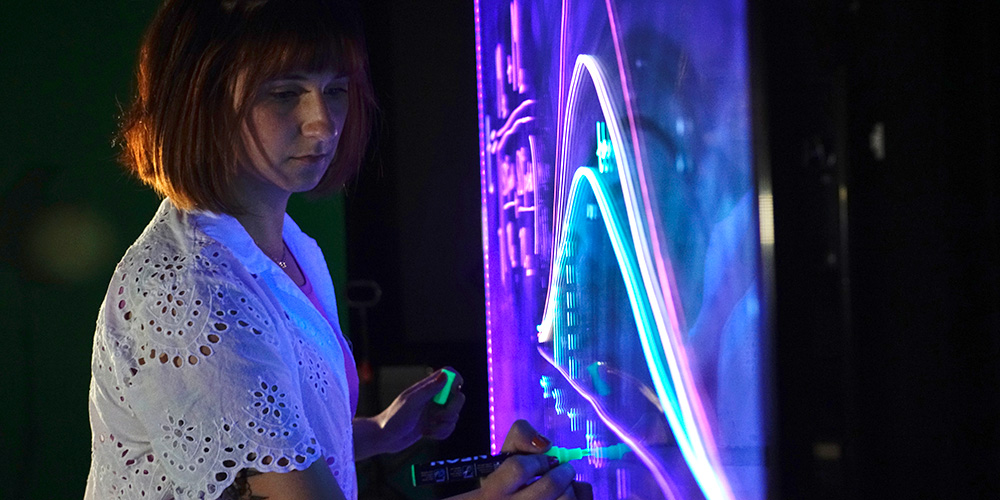
How Does Math Anxiety Divide Society?
By Jenna Blyler
“Most fear is learned,” said Assistant Professor of Psychology Dr. Amanda McGraw.
It could have started at an elementary school chalkboard, etching an incorrect problem set at the front of a class that erupted in laughter, or when a parent asserted that you’re just not “a math person” after you earned a test score poorer than expected. For many, math anxiety takes root in elementary school, particularly and most noticeably in women. Why?
Occupational segregation. In the early 1900s, 20 percent of women—and only 5 percent of married women—worked outside the home. At the time, it was illegal for married women to be employed. Fifty years later, accelerated by the labor force needs of World War II, close to 50 percent of women held jobs; although they were legally paid less than men until 1963 and legally at risk of termination if pregnant or married until 1978. A quarter of employed women in the ’70s worked within just five occupations: bookkeeper, housekeeper, secretary, waitress, and elementary school teacher.
Today, early elementary school teachers in the United States are still primarily female, and when they are math-anxious, this can carry negative consequences for the math achievement of their female students, affecting student perceptions about what groups of people are inherently good or bad at math. This socialization can then influence the anxiety students feel about the subject and their own capabilities.
“How we feel and talk about numbers is often socialized, even generational. Women and men perform almost equally in mathematical tasks; the real difference lies in who is most anxious about it and why,” said McGraw. “Many studies suggest women may feel more math anxiety than men. Further, regardless of gender, math anxiety is negatively related to math performance. When we’re anxious, we’re consumed with negative thoughts, and it results in less mental capacity for us to complete the task at hand, which can result in diminished performance.”
It’s only natural—instinctual—to avoid what scares us. The role of fear is to keep us vigilant and safe. But what happens when certain groups are more avoidant than others of a situation or task is that a social divide emerges in workplaces, governmental spheres, educational environments, and society at large. Voices are missing from the equation.
“If the fields of math and science are to be a common good, then the distribution of benefits regarding that knowledge has to be representative and across all populations of people; diversity is critical to advancing the world and making new discoveries,” said McGraw.
McGraw and counseling psychologist Dr. Victoria McNeil-Young are mutually interested in increasing diversity in academia and are leading studies to examine the relationship between perceived discrimination and test anxiety in students, as studies show that high perceived discrimination correlates with poor academic outcomes. Without interventions for diverse student needs—such as including representative reading materials in coursework, connecting students with centers for inclusion and counseling, and providing a diversity and inclusion statement for class syllabi—minority students can feel further ostracized in the classroom, which becomes a school retention issue that transposes to the everyday workforce. Minority access to STEM education and careers improves racial disparities and advances social equality, and includes views and talents that have historically gone unheard.
In one study, McGraw and McNeil-Young examine if intelligence mindsets—the belief that you can either improve your intelligence or not—impact the relationship between perceived discrimination and test anxiety. An individual who adopts a growth mindset believes their ability is malleable and thus, can be improved. This contrasts with a fixed mindset, where the individual believes their ability is fixed or unable to be improved. These mindsets can influence any type of learning, including mathematical learning. If a connection is found, interventions promoting knowledge about growth mindsets may help reduce anxiety.
Other interventions are also in progress. Alongside Assistant Professor of Mathematics and Chair of the Mathematics Department Dr. Daniel Franz, McGraw is creating resources for students in classes like chemistry or psychology who need a math refresher to be successful in their other advanced courses.
“If you’re not a math major, students are often removed from a lot of the coursework and forget skills that transfer to other areas, which could increase anxiety and hinder performance in these necessary STEM fields. So the math department had this idea to create modules that would be helpful to underlie prerequisite knowledge. Students can refresh the prerequisite information themselves,” said McGraw.
The modules, funded by the Florida Department of Education, allow students to practice at their own will and pace, which also aims to reduce math-related anxiety and keep students on track for graduation. Here McGraw assesses how well students interact with the program, how important they perceive math to be, and their general level of anxiety.
While McGraw’s studies are underway in learning more about math anxiety and how to reduce it, there are several popular math myths that, when acknowledged and corrected, can make an exponential difference in self-perception and performance.
One: Intelligence isn’t fixed; you can absolutely increase your intelligence and capabilities through reading, practicing, and exploring new subjects. Two: Believe it or not, math is one of the most improvable areas in academics, more quickly than reading and comprehension. Three: Our biology is not the only thing that assigns us as a “math person” or not, our environment plays an equally important role; that misconception is largely due to society’s historical restraints on minorities in education and the workforce. Knowing this, in addition to including anxiety reduction measures in the classroom, will over time open more doors for minorities in STEM fields.
